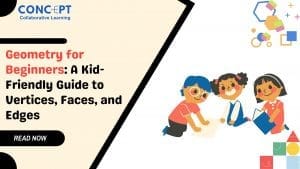
Geometry for Beginners: A Kid-Friendly Guide to Vertices, Faces, and Edges
Geometry isn’t just a chapter in your math textbook; it’s a fascinating and essential part of the world around us! Aimed at beginners, especially kids, this guide will take you on an exciting journey through the basics of geometry, focusing on vertices, faces, and edges. Get ready to explore, learn, and have fun with shapes!
Introduction to Geometry for Beginners
Geometry is all about shapes and their properties. Whether you realize it or not, you encounter geometry in your everyday life—from the design of your favorite video game to the structure of the playground slide. Understanding the basics of geometry can help in your studies and understanding the world better.
Understanding the Basics: Vertices, Faces, and Edges
- Definition of Vertices: A vertex (plural: vertices) is a point where two or more lines meet. Think of it as a corner. For example, a triangle has three vertices.
- Definition of Faces: A face is a flat surface on a shape. A cube, for example, has six faces, each in the shape of a square.
- Definition of Edges: An edge is where two faces meet. It’s like the line you get when you fold a piece of paper. A cube has 12 edges.
Exploring Shapes in Geometry
- Triangles: Triangles are three-sided shapes. They have three vertices three edges, and one face.
- Squares and Rectangles: These four-sided shapes have four vertices and four edges. A square has equal sides, while a rectangle has equal and opposite sides.
- Circles and Ellipses: Unlike polygons, circles, and ellipses don’t have vertices or edges, but they are still important geometric shapes.
Geometry in the Real World
Everyday objects and natural formations are full of geometric shapes. Your soccer ball is a sphere, and honeycombs are hexagonal prisms. Noticing these shapes can make learning geometry more interesting and relevant.
Hands-On Geometry Activities for Kids
- Building Shapes with Craft Sticks: Use craft sticks to create different shapes. This hands-on activity helps in understanding the properties of shapes.
- Drawing and Identifying Shapes: Practice drawing shapes and identifying their vertices, faces, and edges. It’s a fun way to learn geometry basics.
Geometry and Technology
Geometry is crucial in technology, from designing computer graphics to architectural plans. There are also many interactive geometry apps available that make learning fun and engaging. Read this guide for GCSE Maths 2024 Exams
Advanced Concepts Made Simple
- Polygons and Polyhedra: A polygon is a flat shape with straight sides. A polyhedron is a 3D equivalent, like a cube or pyramid.
- Symmetry in Shapes: Symmetry is when one half of a shape mirrors the other. It’s an interesting concept that’s visually appealing and important in geometry.
Geometry in Mathematics and Beyond
Geometry isn’t just for math class; it’s used in art, science, and engineering. Understanding geometry helps in solving complex problems in various fields.
Challenges and Quizzes
Try out geometry quizzes and interactive challenges. They’re a fun way to test your knowledge and learn new concepts.
Helpful Resources for Learning Geometry
There are many books, websites, and online courses available that make learning geometry easy and enjoyable. Explore these resources to deepen your understanding.
Conclusion
We’ve covered the basics of vertices, faces, and edges, and explored how geometry plays a role in our everyday lives. Keep observing, experimenting, and learning to discover more about the amazing world of geometry! Find an experienced Online GCSE Maths Tutor to perform good marks
FAQs
Q. What is the easiest way to remember the difference between vertices, faces, and edges?
Think of vertices as corners, faces as flat surfaces, and edges as the lines where two faces meet.
Q. Can geometry be learned through games and apps?
Absolutely! There are many educational games and apps designed to make learning geometry fun and interactive.
Q. Is understanding geometry helpful in subjects other than math?
Yes, geometry is used in art, science, engineering, and even in everyday problem-solving.
Q. How can parents encourage their kids to learn geometry?
Engage in hands-on activities, use real-life examples, and explore geometry-focused games and apps together.
Q. Are there any interesting books or resources for kids to learn geometry?
Many children’s books and online resources make geometry learning fun and accessible. Look for ones with lots of illustrations and interactive elements.
